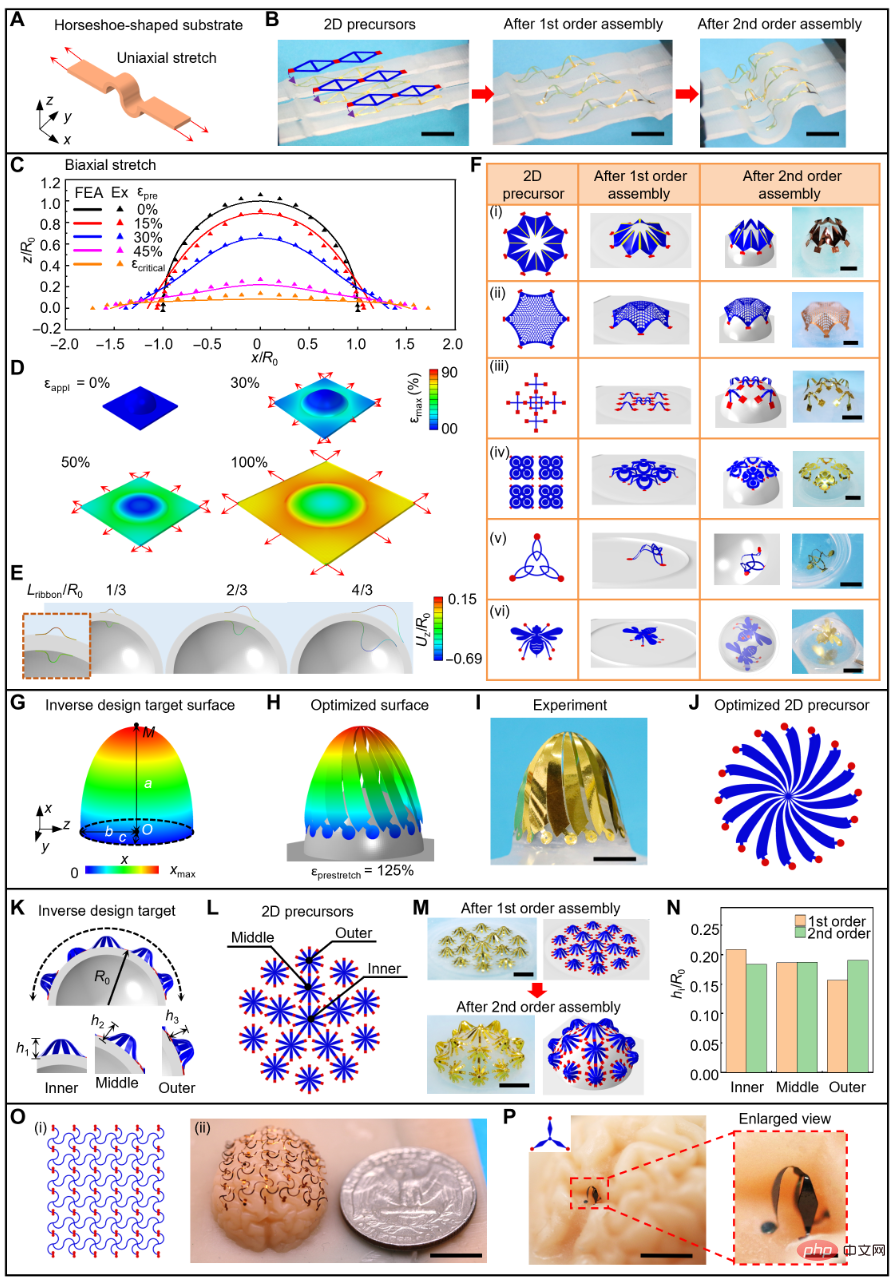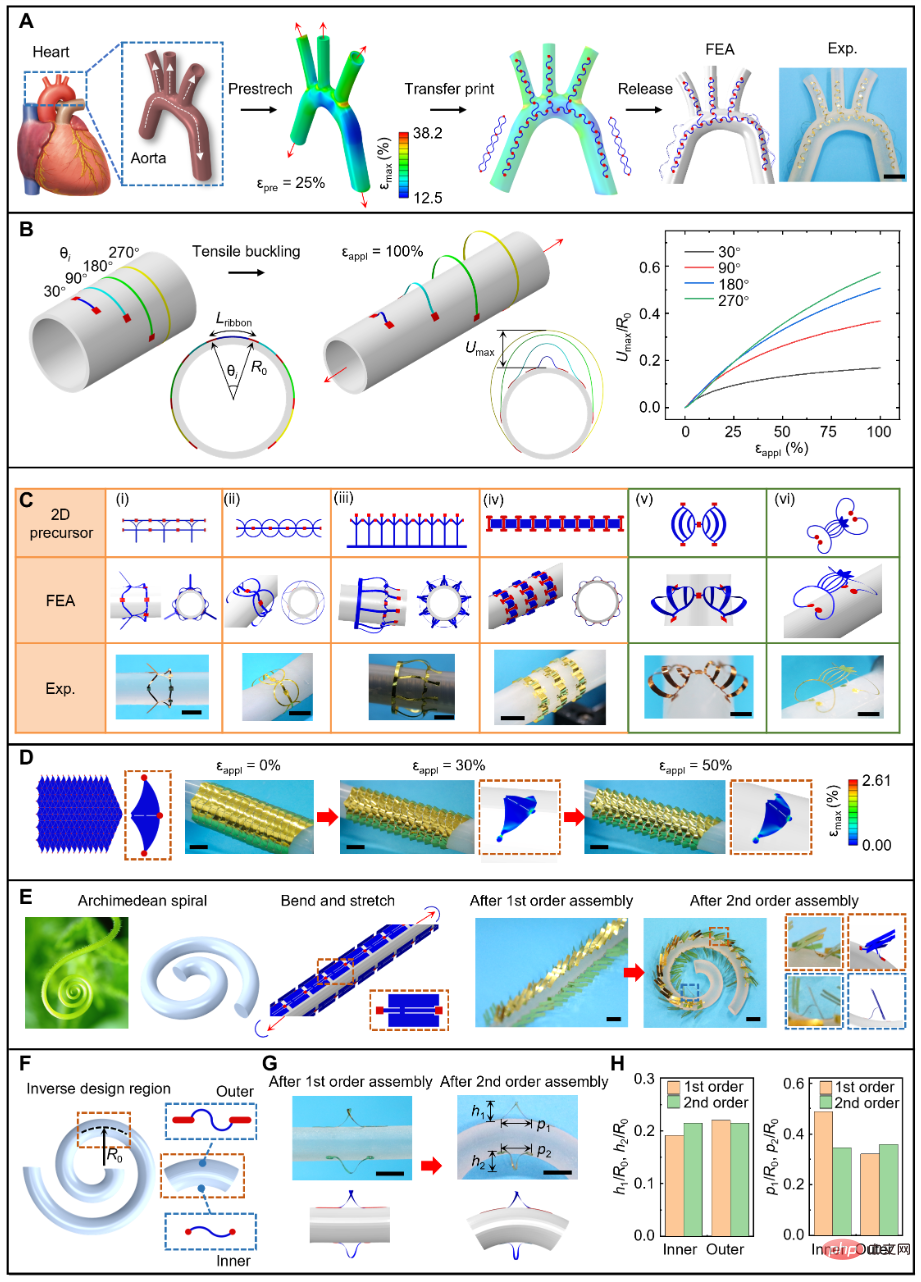
In industrial practice, the assembly of parts and electronic equipment is a key link for the normal operation of complex mechanical equipment. In the past, the substrates on which these components were assembled were mainly flat, and the few parts assembled on curved surfaces were mostly limited to simple structures and difficult to modify.
For complex three-dimensional structural parts, can it be installed on a curved substrate while making it easy to install and modify? Recently, the team of Professor Zhang Yihui of Tsinghua University proposed a new assembly strategy to solve this problem, and published the results in the latest issue of Science Advance.

Paper link: https://www.science.org/doi/10.1126/sciadv.abm6922
The paper mentioned that electronic devices with engineered three-dimensional structures are essential for friction sensing, wide-field optical imaging and flow velocity measurement. Recent advances in mechanically guided assembly establish defined three-dimensional structural routes in high-performance materials through controlled rolling/folding/bending deformations. However, the resulting three-dimensional structures are mostly formed on flat substrates and cannot be directly transferred to another curved substrate.
This study introduces an ordered assembly strategy that can transform 2D films into complex 3D structures on different curved surfaces. This strategy utilizes predetermined mechanical loading to deform the curved elastomeric substrate into a planar/cylindrical structure, which is then driven by additional uniaxial/biaxial pretensioning to drive the buckle-guided assembly.
Through mechanical modeling, the predetermined load can be accurately released and the parts with complex three-dimensional structures can be assembled in an orderly manner on the curved surface. In the example in this article, dozens of these are assembled on a curved base. Structure-like parts. These include tunable dipole antennas, flow sensors in water pipes, integrated electronic systems that can be conformally integrated with the heart, and more.

The picture above is a conceptual diagram of the orderly assembly strategy of complex three-dimensional structures on curved surfaces. .
(A) Use the formation of a three-dimensional decorative mask of the human face to illustrate the orderly assembly strategy. The two images on the right correspond to finite element analysis predictions and optical images of the three-dimensional structure in a silver (5 m) and PET (75 m) bilayer.
(B) The picture above is a finite element analysis result of a spiral base and a spiral base that can be flattened by torsional and tensile loads. The bottom panel shows the ordered assembly process of three-dimensional leaf-like structures on a spiral substrate, along with finite element analysis predictions and optical imaging images.
(C) Conceptual diagram of assembling a three-dimensional structure on the inner surface of a cylindrical tube. Before integration with the two-dimensional precursor, the substrate is cut obliquely and flattened by bending deformation. , and then pre-stretched. The bottom panel shows the orderly assembly process of a layered three-dimensional helical structure [aluminum (2.5m)/PET (30m)] inside a cylindrical tube, accompanied by finite element analysis predictions and optical images.
(D) Illustration of the assembly process of three-dimensional structures on a substrate with a Möbius strip shape, and an ant-like structure assembled on the substrate [Al (2.5 m)/ PET (30 m)] finite element analysis predictions and optical images.

The picture above shows a complex three-dimensional structure assembled on a curved surface that can be flattened.
(A) is a schematic diagram of a horseshoe-shaped curved base, which can be flattened by uniaxial stretching. (B) Optical image illustrating the assembly process of three-dimensional ribbon structures on a horseshoe-shaped substrate. (C) Finite element analysis and empirical results of the generative matrix profile of a hemispherical elastomeric substrate under varying degrees of biaxial stretching. R0 represents the radius of the initial hemisphere. (D) Finite element analysis prediction of the maximum principal strain profile of a hemispherical matrix under varying degrees of biaxial stretching.
(E) Comparison of straight ribbons (Lribbon) of different lengths assembled on a hemispherical base as predicted by finite element analysis. (F) 2D geometries, FEA predictions, and experimental images of various 3D structures assembled on the convex and concave surfaces of a hemispherical substrate. G to J: Inverse design of a semi-elliptical surface assembled on a hemispherical base. (K to N) Inverse design of small hemispheres with the same height (hi) assembled at different spatial locations on a hemispherical base. (O and P) Optical images of a network of spiral microscale structures and tiny three-dimensional rhombohedral ribbon-like microstructures assembled on the surface of a brainoid.

The picture above shows the assembly of a complex three-dimensional structure on a cylindrical/quasi-cylindrical surface.
(A) Schematic illustration of the aorta model used as a curved base and the assembly process of helical and double helix structures on this base by compression buckling.
(B) The process of assembling straight strips of different lengths on a cylindrical base through tensile buckling.
(C) Two-dimensional geometries, finite element analysis predictions and experimental images of various three-dimensional structures assembled on cylindrical substrates.
(D) Experimental images of 2D precursor, finite element analysis predictions, and kirigami-inspired scale-like 3D structures formed by tensile buckling.
(E) Finite element analysis predictions and experimental images demonstrate the orderly assembly process of kirigami-inspired arrays of scale structures on Archimedean spiral fibers.
(F to H) Reverse design of assembling helical structures with the same height and spacing at different spatial regions on the helical fiber.

The corresponding author of this article is Dr. Zhang Yihui, Department of Engineering Mechanics, School of Aeronautics and Astronautics, Tsinghua University Permanent professor.
Received a PhD degree from the Department of Engineering Mechanics, School of Aerospace and Astronautics, Tsinghua University in 2011. From 2011 to 2015, he served as Postdoctoral Fellow and Research Assistant Professor in the Department of Civil and Environmental Engineering at Northwestern University. In 2015, he joined the Department of Engineering Mechanics of Tsinghua University and served successively as associate professor, permanent associate professor and permanent professor.
The main research fields are mechanics-guided three-dimensional microstructure assembly, unconventional soft materials, flexible and malleable electronic devices, smart materials and structural mechanics. So far, 5 authorized Chinese invention patents have been obtained , 3 U.S. invention patents, 1 academic monograph, and more than 150 SCI papers, among which the corresponding author has been published in "Science", "Nature", "Nature Materials", "Nature Electronics", "Nature Reviews Materials", " He has published more than 80 high-level academic papers in journals such as Nature Communications, Science Advances, PNAS, JMPS, Advanced Materials, and ACS Nano.
The two co-first authors, Xue Zhaoguo and Jin Tianqi, are both from the Applied Mechanics Laboratory of the Department of Engineering Mechanics of Tsinghua University. Xue Zhaoguo is mainly responsible for conceptualization, data curation, formal analysis, funding acquisition, investigation, methodology, project management, resources, software, validation, visualization, paper writing, review and editing. Jin Tianqi is mainly responsible for conceptualization, data management, formal analysis, investigation, methodology, software, visualization and paper writing.
The above is the detailed content of Tsinghua's Black Technology appears on the cover of Science: a film is attached to a round tube to transform it into a complex 3D structure in seconds. For more information, please follow other related articles on the PHP Chinese website!




